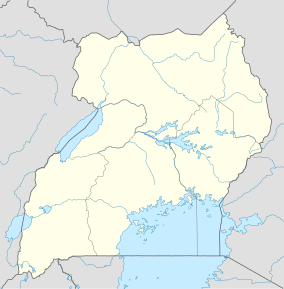| Bwindi Impenetrable Forest | |
|---|---|
 | |
 | |
| Location | Kanungu District, Uganda |
| Nearest city | Kanungu |
| Area | 331 km (128 sq mi) |
| Governing body | National Environment Management Authority of Uganda |
| Website | https://bwindiimpenetrablenationalpark.com |
| UNESCO World Heritage Site | |
| Type | Natural |
| Criteria | vii, x |
| Designated | 1994 (18th session) |
| Reference no. | 682 |
| Region | Africa |

The Bwindi Impenetrable Forest is a large primeval forest located in south-western Uganda and is located in three districts of Kisoro, Kabale and Kanungu. The Bwindi forest is on the edge of the Albertine Rift, the western branch of the East African Rift, at elevations ranging from 1,160 to 2,607 metres (3,806 to 8,553 ft). The forest contains around 160 species of trees and over 100 species of ferns. Bwindi Impenetrable Forest Reserve was set up in 1942 on the rim of the Rift Valley.
Origin of name
The name Bwindi is derived from the Runyakitara word Mubwindi and means "a place full of darkness". This name comes from the extensive stands of bamboo interspersed amongst the larger forest hardwoods. The bamboo and thick ground cover of ferns, vines, and other plant growth severely hinder direct access on foot. Also known as the "Place of Darkness", the forest is on the edge of the western arm of the Great Rift Valley, only a few kilometers from the Democratic Republic of the Congo (DRC) border and about 25 kilometres (16 mi) north of the Virunga Mountains.
Wildlife
The forest is one of the most biologically diverse areas on Earth. Half of the world's population of the highly endangered mountain gorillas live within its borders. The forest has been recognized by the United Nations Educational, Scientific and Cultural Organization as a World Heritage Site for its biological significance.
At present the forest is believed to contain 120 mammals species, 348 bird species, 220 butterfly species and 27 frog species. Included among the mammals are forest elephants and yellow-backed duikers. While mountain gorillas are the most notable of the forest's primates (provides shelter to more than half the world’s population of Mountain Gorillas), other residents include chimpanzees, blue monkeys, l’Hoest’s monkeys, red-tailed monkeys, vervet monkeys and black-and-white colobus monkeys. The forest's birds include great blue turacos, black-billed turacos, black bee-eaters, African green broadbills, handsome francolins, African black ducks and Cassin’s grey flycatchers, white-tailed blue flycatcher, brown-necked parrot, and white-bellied robin chat.
Socioeconomic struggles
The forest has been described as "Riven by disputes and crosshatched by historical, political, and biological borders" by researcher Craig Stanford, co-director of the park's Jane Goodall Research Center. The forest is the traditional home of the Batwa people, a marginalized community within Ugandan society.
Establishment of a national park
In 1991, the Bwindi Impenetrable National Park was established, adjacent to the Uganda, Rwanda and DRC border region. The park was created to protect the forest's mountain gorilla population from poachers and habitat destruction. Gorilla treks are led on a daily basis into different sections of the forest so that trekkers can see the mountain gorillas and in so doing generate necessary funds for the protection of these endangered primates. The Batwa people lost their traditional hunting grounds through the establishment of the park.
See also
References
- "Bwindi Impenetrable National Park". UNESCO World Heritage Centre. Retrieved 2021-09-09.
- ^ "Bwindi Impenetrable Forest National Park Uganda". Bwindi. Retrieved 2024-06-22.
- "Bwindi Impenetrable National Park Gorilla Trekking". Archived from the original on 19 September 2013. Retrieved 22 December 2013.
- "Bwindi Impenetrable National Park - UNESCO World Heritage Centre". Retrieved 22 December 2013.
- "Bwindi Impenetrable National Park | Institute of Tropical Forest Conservation". itfc.must.ac.ug. Retrieved 2021-05-29.
- "Bwindi Impenetrable National Park". UNESCO World Heritage Centre. Retrieved 2021-05-29.
- "Trekking with Mountain Gorillas | Visit Virunga National Park". Visit Virunga. Retrieved 2021-05-29.
- "Why You Need to See Africa's Mountain Gorillas in Uganda". Adventure. 2018-01-25. Archived from the original on February 25, 2021. Retrieved 2021-05-29.
- ^ "Animals & Wildlife in Bwindi Impenetrable Forest National Park". Bwindi Impenetrable National Park. Retrieved 2021-09-09.
- "Bwindi Impenetrable Forest - National Parks | Uganda Parks". 2019-04-05. Retrieved 2024-06-22.
- "Craig Stanford describes Bwindi forest as a place Riven by disputes and crosshatched - Google Search". www.google.co.ug. Retrieved 2021-05-29.
- "Bwindi Impenetrable Forest, Uganda". Trek Zone. Retrieved 2021-05-29.
- UOBDU (2021). "United Organisation for Batwa Development in Uganda (UOBDU)". Archived from the original on 2019-08-31.
- ^ "Batwa". Minority Rights Group. Retrieved 2021-09-09.
External links
- Official website
- Bwindi Park Travel Planner
- Bwindi Forest Park . Organising Safaris and Tours to Bwindi Impenetrable forest.